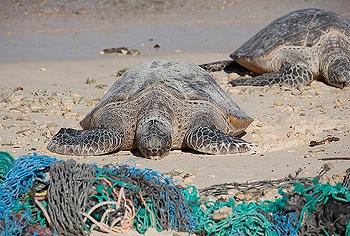
SAN FRANCISCO, California, December 12, 2012 (ENS) – Appalled by the amount of plastic debris floating in the Pacific Ocean, the nonprofit Center for Biological Diversity is petitioning the federal government to designate the Northwestern Hawaiian Islands as a Superfund site.
The Center’s petition was filed Tuesday with the U.S. Environmental Protection Agency, which operates the Superfund program to identify and clean up the country’s most hazardous sites.

The petition is the first time that plastic-polluted waters of the United States have been nominated for a Superfund designation.
The area proposed for designation includes that portion in U.S. waters of the Pacific Garbage Patch, a swirling gyre of litter in the north Pacific Ocean larger than the state of Texas.
“The waters of the Northwestern Hawaiian Islands contain thousands of pounds of plastic bags, bottles and other toxic litter that’s deadly to seals, birds and other marine wildlife,” said Emily Jeffers, an attorney with the Center. “Something this big and disgusting needs the kind of attention that only a Superfund designation can provide.”
On June 15, 2006, President George W. Bush issued a public proclamation creating a national monument of the Northwestern Hawaiian Islands, thus forming the single largest conservation area under the U.S. flag, and one of the largest marine conservation areas in the world.
It encompasses a 1,200-mile stretch of coral islands, seamounts, banks and shoals as well as 139,797 square miles of the Pacific Ocean – an area larger than all U.S. land-based national parks combined.
In 2007, the Marine National Monument was given its Hawaiian name, Papahānaumokuākea (pronounced Pa-pa-hah-now-mo-koo-ah-keh-ah), which comes from an ancient Hawaiian tradition concerning the genealogy and formation of the Hawaiian Islands.
In 2008, the Marine National Monument received additional protection under a new internationally recognized designation as a Particularly Sensitive Sea Area. The designation applies measures designed to protect marine resources of ecological or cultural significance from damage by ships while helping keep mariners safe.
In 2012, Papahānaumokuākea was declared a cultural and natural World Heritage Site by the United Nations.
But despite all these layers of official protection, the waters, reefs and shores of these far-flung atolls and islands are littered with plastic debris.
The Center points out in its petition that this plastic litter kills or injures wildife every year while contaminating the environment with toxic chemicals.

Endangered Hawaiian monk seals, sea turtles and other animals are entangled in the plastic, strangled or lacerated; some are drowned.
Still others starve after consuming plastic because it creates false feelings of satiation. Nearly all Laysan albatross chicks in the Northwestern Hawaiian Islands have plastic in their stomachs, fed to them by their parents who believe the plastics are food, said Jeffers.
“These deadly garbage patches have been ignored for decades and only gotten bigger,” Jeffers said. “If we’re serious about stopping plastic pollution from killing wildlife, we need to start the cleanup now.”
The EPA’s Superfund program is conducted under the Comprehensive Environmental Response, Compensation, and Liability Act, passed in 1970 to protect human health and the environment from hazardous substances.
Before a site becomes eligible for cleanup and remediation, the EPA must evaluate it to determine the extent and nature of the contamination. The Center’s petition calls on the agency to gather data and assess the nature and extent of plastic pollution in the Northwestern Hawaiian Islands.
Papahānaumokuākea Marine National Monument is managed jointly by three cotrustees – the Department of Commerce, Department of the Interior and the state of Hawaii – who are tasked with implementing a cooperative conservation approach to protecting the entire ecosystem.
But monument management agencies say they cannot keep pace with the 57 tons of marine debris entering monument waters each year.
In February, the Advisory Council for NOAA’s Northwestern Hawaiian Islands Coral Reef Ecosystem Reserve approved a resolution supporting a fee on single-use plastic and paper grocery bags. The council believes a fee on single-use plastic and paper bags would reduce marine plastic pollution and litter throughout the islands while also promoting the use of reusable bags.
“Plastic bags are deadly to wildlife and eventually deadly to us,” said Linda Paul, vice chair of the Reserve Advisory Council. “We need to stop using plastic bags.”
The council believes a fee on single-use plastic and paper grocery bags would result in reduce marine plastic pollution and litter throughout the islands and encourage the use of reusable bags.
Although each of Hawaii’s counties has individually passed a plastic bag ban, effectively imposing a state-wide ban, approximately 500 million plastic bags were used in Hawaii each year before 2012, nearly 385 bags for each state resident.
Copyright Environment News Service (ENS) 2012. All rights reserved.
© 2012, Environment News Service. All rights reserved. Content may be quoted only with proper attribution and a direct link to the original article. Full reproduction is prohibited.
